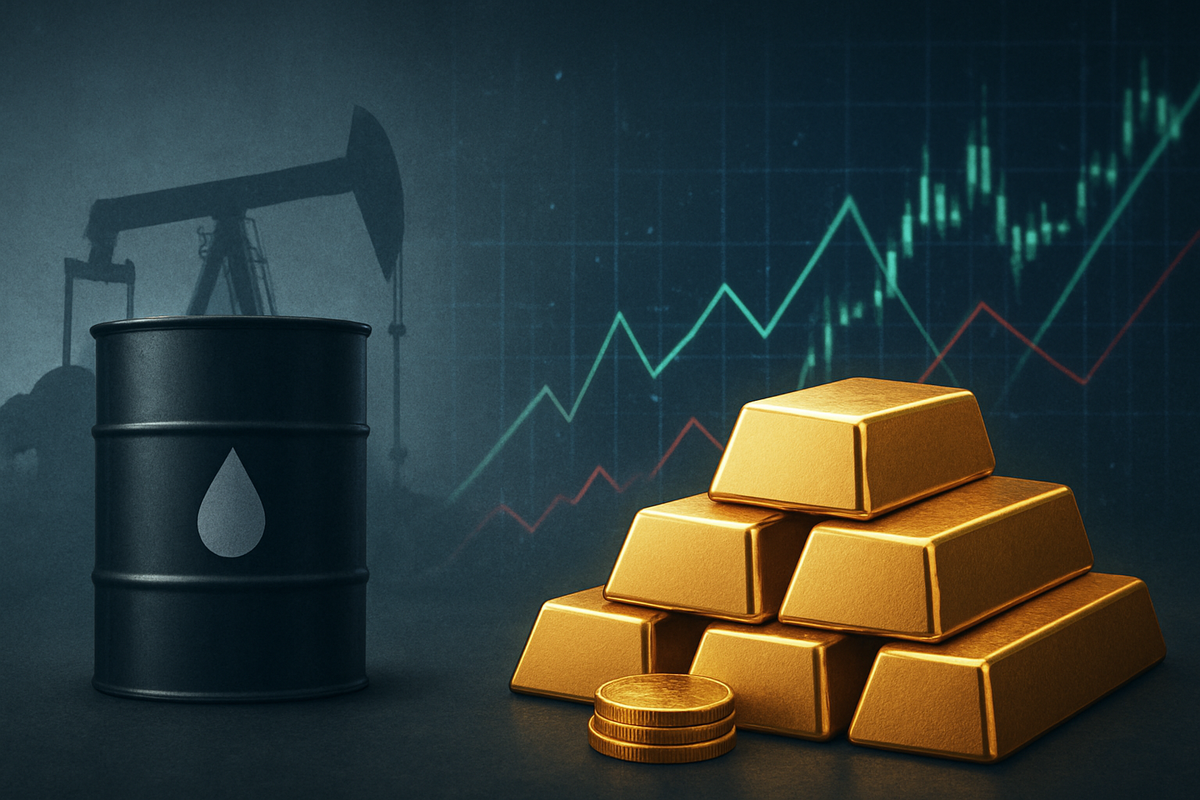
London, UK – November 14, 2025 – The global financial markets are currently navigating a complex landscape shaped by divergent trends in key commodity prices. As of mid-November 2025, crude oil is grappling with a significant supply surplus, exerting downward pressure on prices and consequently impacting the energy sector. Conversely, gold continues its robust performance, driven by persistent geopolitical uncertainties and a flight to safety, signaling a cautious undertone in the broader market. These distinct movements are creating a nuanced influence on stock valuations, rewarding some sectors while challenging others.
This dichotomy presents a fascinating study for investors, as the traditional correlations between commodity prices and stock market performance are being tested. While lower oil prices could provide a much-needed tailwind for energy-intensive industries and consumer spending, the strength of gold underscores a lingering apprehension about global economic stability and future monetary policy trajectories. Understanding these dynamics is crucial for investors seeking to position their portfolios effectively in the current environment.
Oil's Oversupply Dilemma and Gold's Enduring Appeal
The narrative in the oil market is overwhelmingly dominated by an anticipated glut in supply. Brent crude oil is trading around $64.53 per barrel, while WTI crude oil hovers near $60.19 per barrel as of November 14, 2025. Both benchmarks are significantly lower than a year ago, with WTI having seen dips towards $58 per barrel earlier in the week. This bearish sentiment is fueled by a confluence of factors. The International Energy Agency (IEA) has issued stark warnings of an increasingly unbalanced market, projecting a substantial rise in global inventories, with a surplus potentially reaching 4 million barrels per day next year. Similarly, the Organization of the Petroleum Exporting Countries (OPEC) has reversed earlier forecasts, now anticipating a well-supplied market and a surplus in Q3, with global oil production expected to align with demand only by 2026.
Contributing to this oversupply is increased output from the United States and a faster-than-expected rise in OPEC+ production. While geopolitical events, such as Ukrainian drone attacks on Russian ports and impending U.S. sanctions on Russian oil trading units, introduce some supply-side risks, these are currently outweighed by the broader concerns of a global oil glut. The U.S. Energy Information Administration (EIA) has also reported another inventory build, reinforcing fears of excess supply. Analysts anticipate Brent crude to average around $66.16 in the next 12 months, though the EIA revised its 2025 forecast down to $68.76 per barrel, further dropping to $54.92 per barrel in 2026, highlighting the persistent downward pressure.
In stark contrast, gold prices have demonstrated remarkable resilience and strength. On November 14, 2025, spot gold was trading around $4,101.18 per troy ounce, a modest daily decrease but still a staggering 60.04% higher than a year ago. Gold reached an all-time high of $4,381.58 in October 2025, underscoring its role as a premier safe-haven asset. This sustained rally is propelled by ongoing geopolitical turmoil, uncertainty stemming from significant backlogs of U.S. economic data following a government shutdown, and general market volatility. Investors are flocking to gold as a hedge against these uncertainties.
Monetary policy expectations also play a crucial role. While hopes for immediate Federal Reserve rate cuts have been somewhat tempered, the potential for accommodative policies in a soft macroeconomic environment continues to support gold. Lower interest rates typically reduce the opportunity cost of holding non-yielding assets like gold. Furthermore, gold acts as a formidable hedge against inflation and currency weakness, thriving when inflation outpaces interest rates or when the U.S. dollar weakens. A significant structural driver is the robust accumulation of gold by central banks globally, many of whom are actively pursuing de-dollarization strategies and planning to increase their gold holdings, creating consistent demand. Major financial institutions like JPMorgan (NYSE: JPM), Goldman Sachs (NYSE: GS), and Morgan Stanley (NYSE: MS) project gold prices to range between $4,400 and $5,300 per ounce in 2026, with some forecasts even topping $5,000.
Corporate Fortunes Tied to Commodity Swings
The current commodity landscape creates clear winners and losers across various public companies. The downward pressure on oil prices, while challenging for the energy sector, offers a reprieve for oil-consuming industries.
Companies in the transportation sector, such as major airlines like Southwest Airlines (NYSE: LUV) and Delta Air Lines (NYSE: DAL), stand to benefit significantly from lower fuel costs, which directly translate to improved profit margins. Similarly, logistics and shipping companies like FedEx (NYSE: FDX) and UPS (NYSE: UPS) will see their operational expenses reduced, potentially boosting their bottom lines. The manufacturing sector, particularly industries with high energy consumption, including chemical producers like Dow Inc. (NYSE: DOW) and automotive manufacturers like General Motors (NYSE: GM) and Ford (NYSE: F), will also experience a reduction in input costs, which can enhance competitiveness and profitability. Even consumer discretionary companies could see a boost as lower energy costs potentially free up consumer spending power.
Conversely, the energy sector faces considerable headwinds. Oil exploration and production (E&P) companies such as ExxonMobil (NYSE: XOM), Chevron (NYSE: CVX), and Occidental Petroleum (NYSE: OXY) will likely see reduced revenues and profits as the price per barrel falls. This can lead to decreased capital expenditures, slower production growth, and potentially lower valuations. Oilfield services companies like Schlumberger (NYSE: SLB) and Halliburton (NYSE: HAL), which provide drilling, completion, and other services to E&P firms, will also feel the pinch as demand for their services diminishes in a low-price environment. Their stock performance is highly correlated with the activity levels of their clients, making them particularly vulnerable to sustained low oil prices.
For gold, its elevated price directly benefits gold mining companies. Major players like Barrick Gold (NYSE: GOLD), Newmont (NYSE: NEM), and Agnico Eagle Mines (NYSE: AEM) are experiencing higher revenues and profitability, as their production costs remain relatively stable while the selling price of their output surges. This typically leads to stronger earnings reports, increased dividends, and upward revisions in their stock valuations. Investors seeking direct exposure to gold's rally may also turn to precious metals exchange-traded funds (ETFs), such as the SPDR Gold Shares (NYSEARCA: GLD). However, if gold's strength is primarily driven by fear and risk aversion, it could signal a broader rotation out of growth stocks and into more defensive assets, potentially impacting the valuations of companies highly dependent on robust economic expansion and investor optimism.
Broader Economic Implications and Historical Context
The current commodity market trends carry wider significance for the global economy and financial markets. The oversupply in oil, leading to subdued prices, generally acts as a disinflationary force. While surging oil prices often signal inflationary pressures that can prompt central banks to tighten monetary policy, the current environment might provide central banks, including the Federal Reserve, with more flexibility. Lower energy costs could ease consumer price index pressures, potentially allowing for more accommodative monetary policies or delaying further rate hikes, which could be a positive for overall economic growth and, by extension, equity markets. However, a prolonged slump in oil prices could also signal weakening global demand, which would be a negative for the broader economy.
Gold's sustained rally, reaching historic highs, aligns with its traditional role as a safe-haven asset during times of uncertainty. Its strength amidst geopolitical turmoil, U.S. economic data backlogs, and persistent inflation concerns highlights a cautious market sentiment. This also ties into broader trends of de-dollarization, where central banks are diversifying their reserves away from the U.S. dollar, bolstering gold's demand. Historically, gold has often performed well during periods of high inflation, currency devaluation, and geopolitical instability, acting as a store of value when other asset classes falter. The current environment, with its mix of geopolitical tensions and uncertain economic outlooks, echoes historical precedents where gold has served as a crucial hedge against systemic risks. The inverse relationship often perceived between gold and stocks tends to hold true during market crises, as capital flows from riskier equities to safer assets.
Regulatory and policy implications are also at play. Governments in oil-producing nations will face revenue challenges, potentially leading to budget deficits and social unrest, while oil-consuming nations may see a temporary economic boost. The ongoing central bank accumulation of gold suggests a long-term strategic shift in global financial architecture, with nations seeking greater financial autonomy and stability, potentially influencing international trade and currency dynamics.
Navigating the Future: Scenarios and Strategic Pivots
Looking ahead, the trajectory of commodity prices will continue to be a critical determinant for market performance. For oil, the short-term outlook suggests continued pressure from oversupply. The EIA's forecasts of Brent crude averaging $54.92 per barrel in 2026 underscore the expectation of a sustained low-price environment. The key question will be whether OPEC+ will intervene with deeper production cuts to stabilize prices or if global demand growth will eventually absorb the excess supply. A significant uptick in global economic activity could provide a much-needed boost to demand, but current projections suggest a more gradual recovery. Energy companies may need to strategically pivot towards cost efficiency, divest non-core assets, and accelerate their transition to renewable energy sources to remain viable in a low-carbon, low-price future.
For gold, the long-term outlook appears robust, with forecasts from major financial institutions predicting prices between $4,400 and $5,300 per ounce in 2026. Continued geopolitical instability, any further weakening of the U.S. dollar, or a resurgence of inflation could push prices even higher. The Federal Reserve's future interest rate decisions will be paramount; any indication of prolonged accommodative monetary policy or actual rate cuts would further enhance gold's appeal. Conversely, a stronger-than-expected global economic recovery and aggressive rate hikes could temper gold's ascent. Investors should monitor central bank policies, geopolitical developments, and inflation data closely.
Market opportunities may emerge in sectors benefiting from lower oil prices, such as airlines, logistics, and consumer discretionary, while challenges will persist for traditional oil and gas producers. The ongoing strength of gold could signal a continued preference for defensive assets and potentially a rotation away from high-growth, high-valuation stocks if risk aversion deepens. Companies across all sectors will need to adapt to these shifting commodity landscapes, optimizing supply chains, managing energy costs, and hedging against price volatility to maintain competitive advantages.
A Comprehensive Wrap-Up: Key Takeaways for Investors
In summary, the financial markets in November 2025 are characterized by a stark divergence in commodity fortunes: an oil market grappling with oversupply and downward price pressure, and a gold market demonstrating unwavering strength as a safe haven. The key takeaways from this dynamic environment are multifaceted. For oil, the immediate future points to continued challenges for the energy sector, while offering potential tailwinds for oil-consuming industries and, indirectly, for consumer spending. For gold, its elevated status reflects persistent global uncertainties, accommodative monetary policy expectations, and strategic central bank accumulation, indicating a cautious investor sentiment.
Moving forward, investors should anticipate continued volatility and potential sector rotations. The disinflationary impact of lower oil prices could influence central bank decisions, potentially leading to a more dovish stance, which might support broader equity markets. However, gold's robust performance suggests that underlying risks and uncertainties remain prevalent. This implies that while certain sectors may thrive from reduced energy costs, a general flight to safety could temper overall market exuberance, especially for growth-oriented stocks.
What investors should watch for in the coming months includes any shifts in OPEC+ production policy, the pace of global economic recovery, the Federal Reserve's stance on interest rates, and the evolution of geopolitical events. Diversification, including strategic allocations to both commodity-sensitive sectors and defensive assets like gold, remains a prudent approach to navigate these complex market dynamics. The interplay between these critical commodities will undoubtedly continue to shape corporate earnings, investor sentiment, and broader economic trajectories.
This content is intended for informational purposes only and is not financial advice




